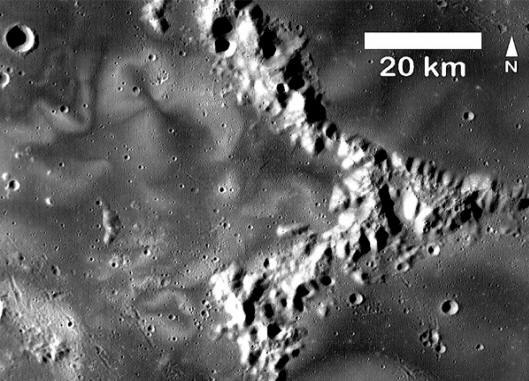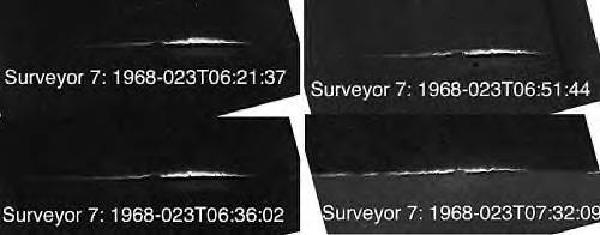


Rough Notes:

Strange glow on the lunar horizon. Credit: NASA/Surveyor 7
Jun 11, 2008
Lunar Dust LevitationStatic electric charge might help to explain the glowing haze sometimes seen rising 100 kilometers above the Moon’s horizon.
Between May 1966 and January 1968, NASA launched the Surveyor missions to the Moon. Each Surveyor spacecraft weighed approximately 450 kilograms and was designed to soft-land on the lunar surface, riding the tip of a retrorocket descent engine. Surveyor 7 made one of the most intriguing discoveries when its onboard camera detected a faint glow in the lunar night, hovering over the horizon.
In 1998, the Lunar Prospector was launched from Cape Canaveral with gamma-ray spectrometer, alpha particle spectrometer, neutron spectrometer, magnetometer and electron reflectometer instrumentation. During several orbits, the spacecraft detected a surprisingly high voltage change as it passed through the magnetotail extending outward from Earth. The magnetotail is actually a part of the plasma sheath that envelops the Earth. The Moon passes through it once a month at full moon phase and the electric differential was found to occur during that passage.
The Earth is surrounded by a magnetic field that is trapped inside a cometary plasma tail that actually stretches well beyond the Moon's orbit. The Earth's magnetospheric tail points away from the Sun due to the high-speed ions streaming from the Sun.
The movement of the Moon through the ionized plasma affects the materials in the lunar regolith. Electrons accumulate and produce a negative charge on the ultra-fine dust particles, causing them to repel each other and drift off the surface.
Charge differential between the day and night side of the Moon might actually generate an ion “wind” flowing from the negatively charged night side into the more positively charged sunlit side. The negative charge on the bright surface during daylight is moderated by the photoelectric phenomenon, while it tends to build up in the darkness, forming static electricity. The charge variation between the two hemispheres has been measured at more than 1000 volts.
Earth's cometary plasma cocoon changes shape and power as electric currents from the Sun bombard our planet. It is sometimes described as a “flag waving” because of somewhat regular oscillations in the field. This means that the Moon does not simply pass through the magnetotail once and briefly, but that electric charges will brush the surface several times during each monthly encounter.
Electric currents exist in space and their effects are varied, depending on the environment. According to the Electric Universe hypothesis, electric currents from the Sun influence Martian weather by initiating gigantic dust storms and “super twisters” larger than Mt. Everest. These filamentary structures are much like those found on Earth, except larger because the ameliorating atmosphere on our planet does not exist on Mars.
In a previous Picture of the Day, activity inside tornadoes and in the magma discharges from volcanoes was found to be of electrical origin. The levitating dust and the faint glow on the lunar horizon are most likely because the Moon has no atmosphere at all, so the electric charges have greater impetus.
The Electric Universe model suggests that transfer of electricity between the Earth and the Moon via the Earth's conducting plasma tail also applies to more distant Mars. Global dust storms on Mars seem to occur preferentially at opposition, and Earth's magnetotail has been detected approaching Mars. Like the Moon, Mars has no magnetosheath, so the same "tail effect" could occur on Mars, where it would influence the thin atmosphere. This would also explain the enigmatic "blue clearing" of the Martian atmosphere when viewed telescopically at opposition. The "blue clearing" refers to a blue atmospheric glow that normally renders surface features on Mars invisible through a blue filter.
By Stephen Smith
Swirls in Mare Ingenii are associated with magnetic anomalies there.
Original image credit: NASA/GSFC/Arizona State University
Lunar Magnetic Anomalies
Nov 15, 2010
The relationship between electricity and magnetism has been known for more than a century.
In a previous Picture of the Day, the complex surface features of the Reiner Gamma Formationwere discussed. It remains a mystery for those who insist on slow, uniform cooling and a relatively stable lunar environment. The swirling pattern of bright material is located inOceanus Procellarum, near Reiner crater.
Recent maps of lunar magnetic anomalies reveal several other formations of high albedo material also associated with areas of crustal magnetism imprinted on the lunar surface.Descartes, the Apollo 16 landing site, possesses a prominent magnetic signature. Powdery swirls in Gerasimovich crater, on the Moon's far side, are estimated to be less than five centimeters thick. Gerasimovich is also notable for its magnetic attribute.
Latent magnetic fields in Mare Marginis and Mare Ingenii were measured by the Lunar Prospector spacecraft in the 1990s. Measurements of the remanent magnetism in the lunar crust were taken by observing the magnetic reflection of electrons from the Moon’s surface. The differences are small, but the evidence points to a variable strength magnetic field imprinted on the Moon. Since magnetism is a result of electrical currents, then the swirling pattern of the various formations could be due to an external electrical influence.
The Lunar Reconnaissance Orbiter's Mini-RF radar imager has returned the most current images of the lunar swirls. A published paper reports: "Lunar swirls appear to overlay the lunar surface, apparently representing diffuse brightening of unmodified terrains. Lunar swirls are associated with regions of anomalously high crustal magnetic fields, but their exact formation mechanism is unknown."
Since magnetism and electricity are so intimately bound together that they are known as one electromagnetic force, why is it puzzling for planetary scientists when confronted with anomalous magnetic signatures, not just on the Moon but on Mars and Mercury as well? Would it be unreasonable to conclude that an electric field impinged on those bodies, leaving behind a remanent magnetic domain?
On Mars, swirling patterns are often seen incised into the rock strata, implying a more powerful electric discharge. The Moon might be less conductive, or might have been spared a direct hit from interplanetary lightning storms, so the eddy currents induced by the arcs could have left shallower impressions. However, the appearance of gigantic craters and maria suggests extreme events that might have impacted its surface.
As Electric Universe theorists postulate, a common explanation for each of the geomorphological features that we have illustrated is that planets and moons exist within an electrically active Solar System that could have been more energetic in the past. Each object is normally insulated within its individual charge sheath. However, if those sheaths touch, electric charge can be exchanged. Those electromagnetic exchanges are what might have created what we see today.
Is there a possibility that those forces will be unleashed again? There is no way to know at this point. Suffice to say, the evidence reveals that they were once active in the recent past.
Stephen Smith